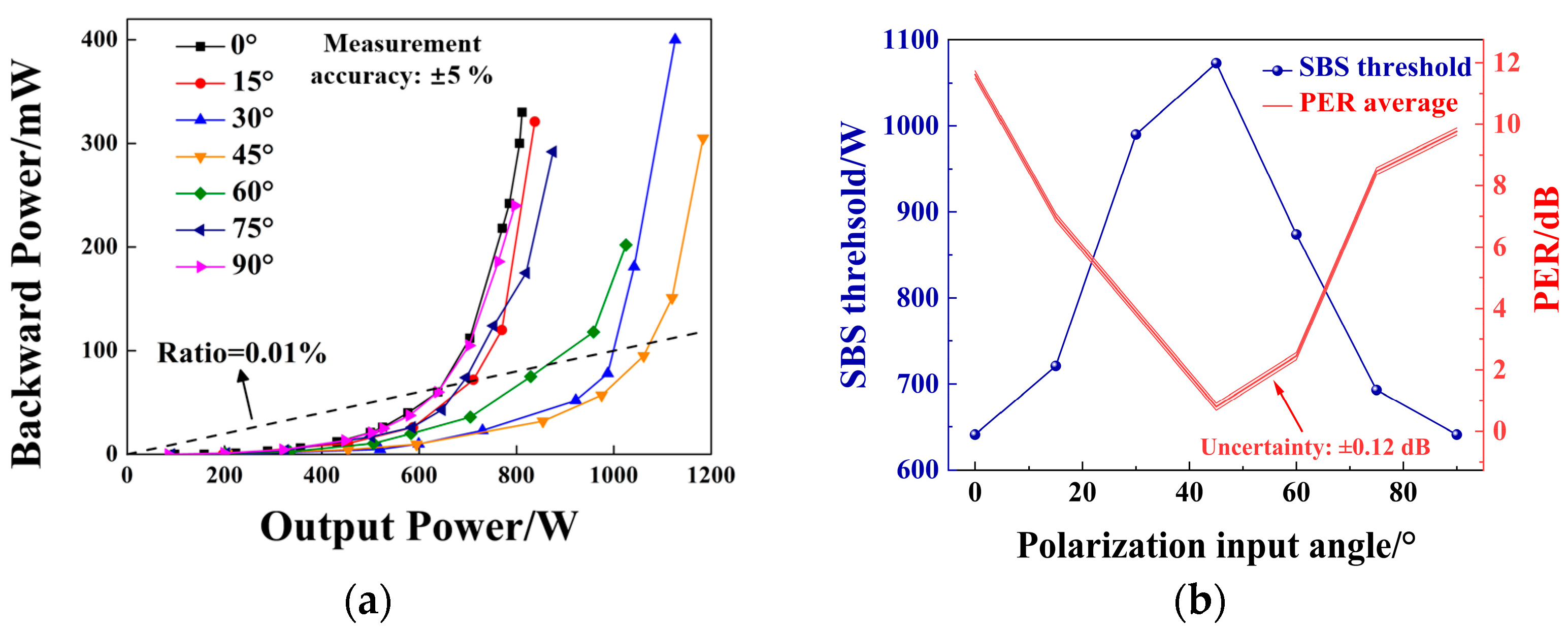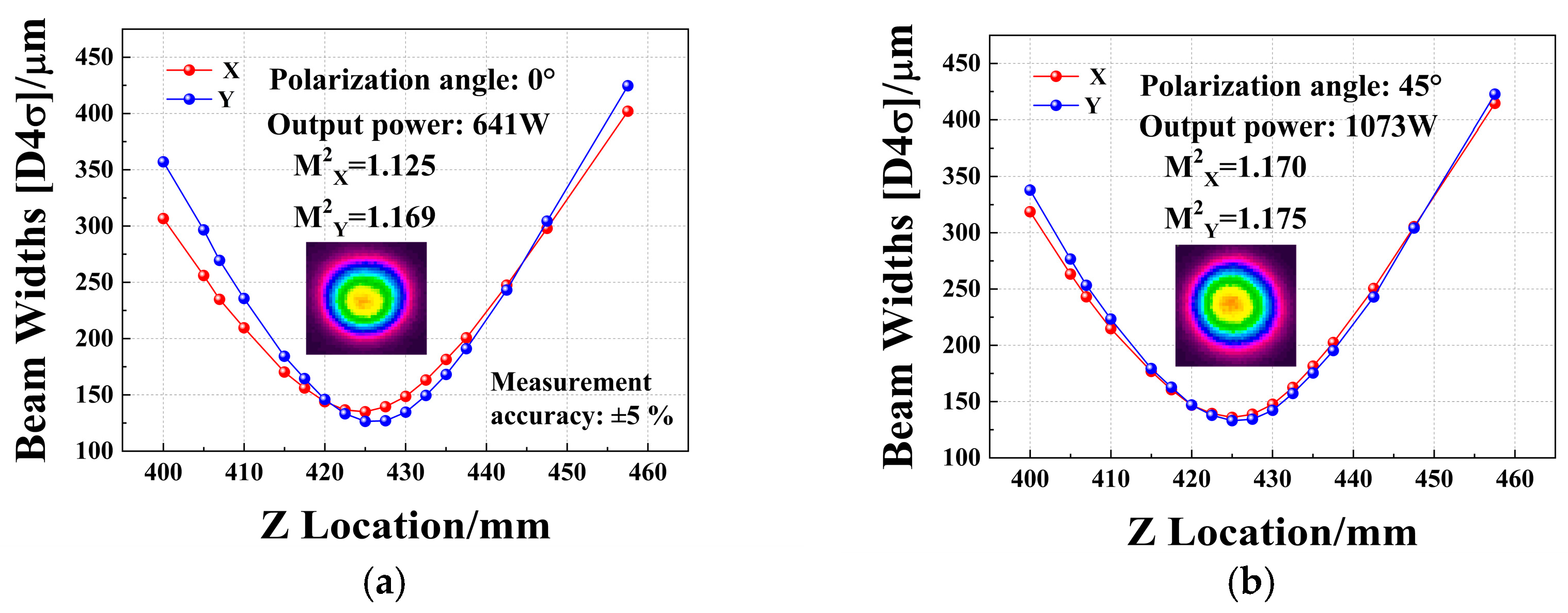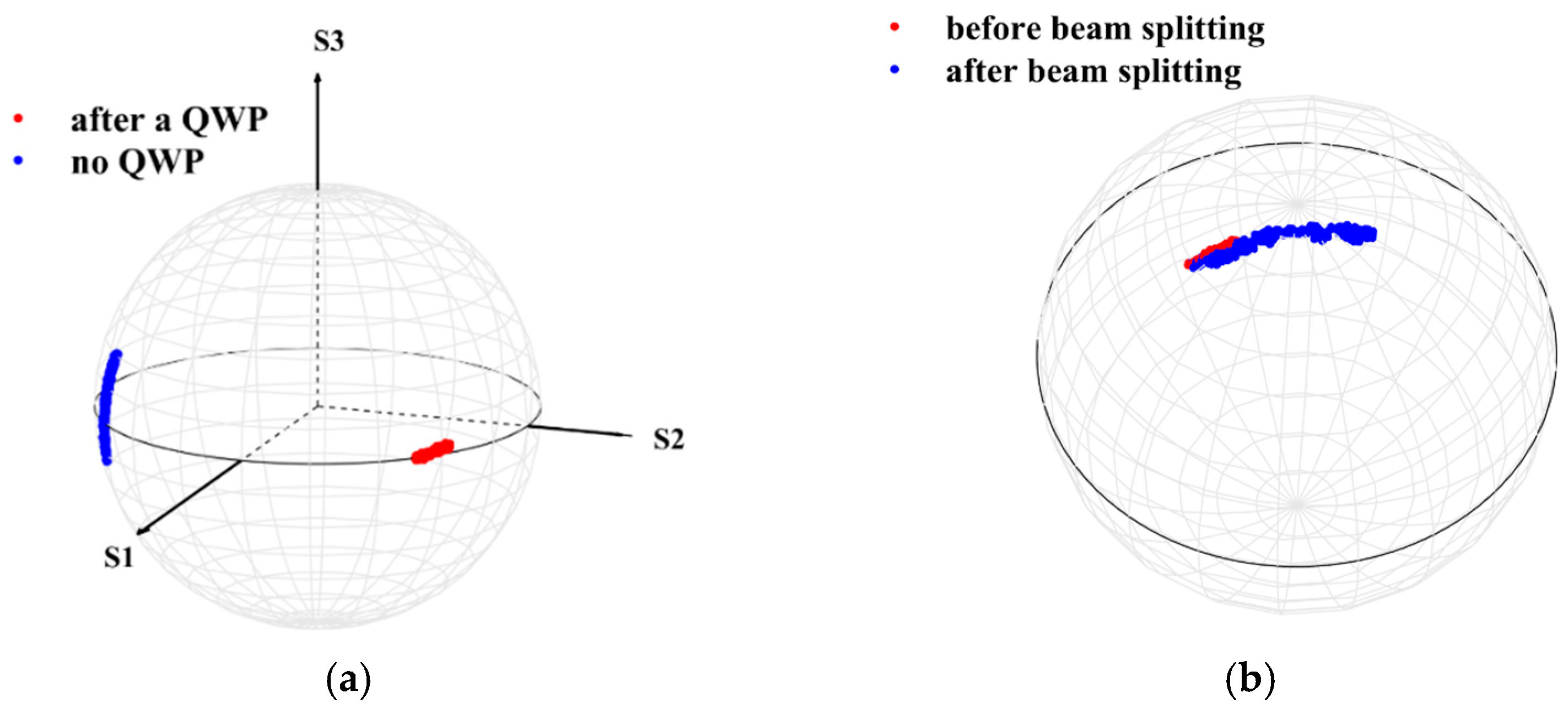SBS Mitigation by Manipulating the Injecting Polarization Direction in a High-Power Monolithic PM Amplifier
Abstract
1. Introduction
2. Experimental Setup
3. Experimental Results
4. Discussion
5. Conclusions
Author Contributions
Funding
Institutional Review Board Statement
Informed Consent Statement
Data Availability Statement
Conflicts of Interest
References
- Jauregui, C.; Limpert, J.; Tünnermann, A. High-Power Fibre Lasers. Nat. Photonics 2013, 7, 861–867. [Google Scholar] [CrossRef]
- Zervas, M.N.; Codemard, C.A. High Power Fiber Lasers: A Review. IEEE J. Sel. Top. Quantum Electron. 2014, 20, 219–241. [Google Scholar] [CrossRef]
- Zhou, P.; Ma, P.; Ren, S.; Chen, Y.; Liu, W.; Yao, T.; Pan, Z.; Chen, J. High-power narrow linewidth fiber laser: Progress and prospect. Inf. Countermeas. Technol. 2023, 2, 16–36. [Google Scholar]
- Tao, R.; Ma, P.; Wang, X.; Zhou, P.; Liu, Z. 13 kW Monolithic Linearly Polarized Single-Mode Master Oscillator Power Amplifier and Strategies for Mitigating Mode Instabilities. Photonics Res. 2015, 3, 86–93. [Google Scholar] [CrossRef]
- Ren, S.; Ma, P.; Chen, Y.; Li, W.; Wang, G.; Liu, W.; Huang, L.; Pan, Z.; Yao, T.; Zhou, P. 5 kW-level narrow linewidth fiber laser output realized by homemade polarization-maintained fiber. Infrared Laser Eng. 2023, 52, 20220900. [Google Scholar]
- Wang, Y.; Peng, W.; Liu, H.; Yang, X.; Yu, H.; Wang, Y.; Wang, J.; Feng, Y.; Sun, Y.; Ma, Y.; et al. Linearly Polarized Fiber Amplifier with Narrow Linewidth of 5 kW Exhibiting a Record Output Power and Near-Diffraction-Limited Beam Quality. Opt. Lett. 2023, 48, 2909–2912. [Google Scholar] [CrossRef]
- Chu, Q.; Shu, Q.; Li, F.; Guo, C.; Yan, Y.; Zhang, H.; Liu, Y.; Tao, R.; Lin, H.; Wang, J. Power Scaling of High-Power Linearly Polarized Fiber Lasers with <10 GHz Linewidth. Front. Phys. 2023, 11, 1198305. [Google Scholar]
- Liao, S.; Luo, T.; Xiao, R.; Shu, C.; Cheng, J.; Zhang, Z.; Xing, Y.; Li, H.; Dai, N.; Li, J. 4.6 kW Linearly Polarized and Narrow-Linewidth Monolithic Fiber Amplifier Based on a Fiber Oscillator Laser Seed. Opt. Lett. 2023, 48, 6533–6536. [Google Scholar] [CrossRef]
- Ippen, E.P.; Stolen, R.H. Stimulated Brillouin Scattering in Optical Fibers. Appl. Phys. Lett. 1972, 21, 539–541. [Google Scholar] [CrossRef]
- Zha, C.; Peng, W.; Wang, X.; Wang, Y.; Li, T.; Ma, Y.; Zhang, K.; Feng, Y.; Peng, J.; Sun, Y. Self-Pulsing in Kilowatt Level Narrow-Linewidth Fiber Amplifier with WNS Phase-Modulation. Opt. Express 2017, 25, 19740–19741. [Google Scholar] [CrossRef]
- Cui, J.; Dang, H.; Feng, K.; Yang, W.; Geng, T.; Hu, Y.; Zhang, Y.; Jiang, D.; Chen, X.; Tan, J. Stimulated Brillouin Scattering Evolution and Suppression in an Integrated Stimulated Thermal Rayleigh Scattering-Based Fiber Laser. Photonics Res. 2017, 5, 233–238. [Google Scholar] [CrossRef]
- Ma, P.; Zhou, P.; Ma, Y.; Su, R.; Xu, X.; Liu, Z. Single-Frequency 332 W, Linearly Polarized Yb-Doped All-Fiber Amplifier with near Diffraction-Limited Beam Quality. Appl. Opt. 2013, 52, 4854–4857. [Google Scholar] [CrossRef]
- Theeg, T.; Sayinc, H.; Neumann, J.; Kracht, D. All-Fiber Counter-Propagation Pumped Single Frequency Amplifier Stage with 300-W Output Power. IEEE Photonics Technol. Lett. 2012, 24, 1864–1867. [Google Scholar] [CrossRef]
- Chang, Z.; Wang, Y.; Sun, Y.; Peng, W.; Ke, W.; Ma, Y.; Zhu, R.; Tang, C. 15 kW Polarization-Maintained Yb-Doped Amplifier with 13 GHz Linewidth by Suppressing the Self-Pulsing and Stimulated Brillouin Scattering. Appl. Opt. 2019, 58, 6419–6425. [Google Scholar] [CrossRef] [PubMed]
- Huang, L.; Wu, H.; Li, R.; Li, L.; Ma, P.; Wang, X.; Leng, J.; Zhou, P. 414 W Near-Diffraction-Limited All-Fiberized Single-Frequency Polarization-Maintained Fiber Amplifier. Opt. Lett. 2017, 42, 1–4. [Google Scholar] [CrossRef] [PubMed]
- Stolen, R. Polarization Effects in Fiber Raman and Brillouin Lasers. IEEE J. Quantum Electron. 1979, 15, 1157–1160. [Google Scholar] [CrossRef]
- Agrawal, G.P. Nonlinear Fiber Optics, 6th ed.; Academic Press: London, UK, 2019; pp. 361–362. [Google Scholar]
- Spring, J.B.; Russell, T.H.; Shay, T.M.; Berdine, R.W.; Sanchez, A.D.; Ward, B.G.; Roh, W.B. Comparison of Stimulated Brillouin Scattering Thresholds and Spectra in Nonpolarization-Maintaining and Polarization-Maintaining Passive Fibers. In Fiber Lasers II: Technology, Systems, and Application, Proceedings of the Lasers and Applications in Science and Engineering, San Jose, CA, USA, 22–27 January 2005; Durvasula, L.N., Brown, A.J.W., Nilsson, J., Eds.; SPIE: Bellingham, WA, USA, 2005; p. 147. [Google Scholar]
- Guintrand, C.; Edgecumbe, J.; Farley, K.; Abramczyk, J.; Tankala, K. Stimulated Brillouin Scattering Threshold Variations due to Bend-Induced Birefringence in a Non-Polarization-Maintaining Fiber Amplifier. In Proceedings of the CLEO: 2014, San Jose, CA, USA, 8–13 June 2014; JW2A.23; OSA: Washington, DC, USA, 2014. [Google Scholar]
- Liao, S.; Luo, T.; Xiao, R.; Zhang, Z.; Xing, Y.; Chu, Y.; Li, H.; Peng, J.; Dai, N.; Li, J. Stimulated Brillouin Scattering Induced Mode Degradation in High-Power Narrow-Linewidth Linearly Polarized Fiber Amplifiers. Opt. Laser Technol. 2023, 162, 109286. [Google Scholar] [CrossRef]
- Naderi, N.A.; Flores, A.; Anderson, B.M.; Dajani, I. Beam Combinable, Kilowatt, All-Fiber Amplifier Based on Phase-Modulated Laser Gain Competition. Opt. Lett. 2016, 41, 3964–3967. [Google Scholar] [CrossRef]
- Beier, F.; Hupel, C.; Kuhn, S.; Hein, S.; Nold, J.; Proske, F.; Liem, A.; Jauregui, C.; Limpert, J.; Haarlammert, N.; et al. Single Mode 4.3 kW Output Power from a Diode-Pumped Yb-Doped Fiber Amplifier. Opt. Express 2017, 25, 14892–14899. [Google Scholar] [CrossRef]
- Meng, D.; Lai, W.; He, X.; Ma, P.; Su, R.; Zhou, P.; Yang, L. Kilowatt-Level, Mode-Instability-Free, All-Fiber and Polarization-Maintained Amplifier with Spectral Linewidth of 1.8 GHz. Laser Phys. 2019, 29, 035103. [Google Scholar] [CrossRef]
- Lin, H.; Tao, R.; Li, C.; Wang, B.; Guo, C.; Shu, Q.; Xu, L.; Wang, J.; Jing, F.; Chu, Q. 3.7 kW Monolithic Narrow Linewidth Single Mode Fiber Laser through Simultaneously Suppressing Nonlinear Effects and Mode Instability. Opt. Express 2019, 27, 9716–9724. [Google Scholar] [CrossRef] [PubMed]
- Zeringue, C.; Dajani, I.; Naderi, S.; Moore, G.T.; Robin, C. A Theoretical Study of Transient Stimulated Brillouin Scattering in Optical Fibers Seeded with Phase-Modulated Light. Opt. Express 2012, 20, 21196–21213. [Google Scholar] [CrossRef] [PubMed]
- Ko, P.; Písa, M. Mode-Field Adapter for Tapered-Fiber-Bundle Signal and Pump Combiners. Appl. Opt. 2015, 54, 751–756. [Google Scholar]
- Zou, S.; Chen, H.; Zhang, J.; Yu, H.; Zhang, Z.; Sun, J.; Lin, X. Cladding Light Stripper of High Average Stripped Power Density with High Attenuation of 39 dB and Low Temperature Rise. IEEE Photonics J. 2018, 10, 7100610. [Google Scholar] [CrossRef]
- Tao, R.; Ma, P.; Wang, X.; Zhou, P.; Liu, Z. Theoretical Study of Pump Power Distribution on Modal Instabilities in High Power Fiber Amplifiers. Laser Phys. Lett. 2017, 14, 025002. [Google Scholar] [CrossRef]
- Tao, R.; Wang, X.; Zhou, P. Comprehensive Theoretical Study of Mode Instability in High-Power Fiber Lasers by Employing a Universal Model and Its Implications. IEEE J. Sel. Top. Quantum Electron. 2018, 24, 1–19. [Google Scholar] [CrossRef]
- Ma, H.; Yuan, X.; Zhang, Y.; Hong, Y.; Wang, L.; Zhang, Y. A Novel Measurement Scheme of the Polarization Extinction Ratio. In Proceedings of the 2015 International Conference on Optical Instruments and Technology: Advanced Lasers and Applications, Beijing, China, 17–19 May 2015; Zhu, J., Gao, C., Eds.; SPIE: Bellingham, WA, USA, 2015; p. 962108. [Google Scholar]
- Xie, W.; Yang, Y.; Wang, H.; Wang, K.; Duan, X.; Liu, K.; Chen, X.; Xiong, X.; Zhang, D.; Meng, J. 3.05 kW, 13.7 GHz Linewidth Fiber Amplifier Based on PRBS Phase Modulation for SBS Suppression. Appl. Opt. 2024, 63, 2994–3002. [Google Scholar] [CrossRef]
- Yang, F.; Ye, Q.; Pan, Z.; Chen, D.; Cai, H.; Qu, R.; Yang, Z.; Zhang, Q. 100-mW Linear Polarization Single-Frequency All-Fiber Seed Laser for Coherent Doppler Lidar Application. Opt. Commun. 2012, 285, 149–152. [Google Scholar] [CrossRef]
- Beier, F.; Möller, F.; Sattler, B.; Nold, J.; Liem, A.; Hupel, C.; Kuhn, S.; Hein, S.; Haarlammert, N.; Schreiber, T.; et al. Experimental Investigations on the TMI Thresholds of Low-NA Yb-Doped Single-Mode Fibers. Opt. Lett. 2018, 43, 1291–1294. [Google Scholar] [CrossRef]
- Taylor, L.R.; Feng, Y.; Calia, D.B. 50W CW Visible Laser Source at 589 nm Obtained via Frequency Doubling of Three Coherently Combined Narrow-Band Raman Fibre Amplifiers. Opt. Express 2010, 18, 8540–8555. [Google Scholar] [CrossRef]
- Jiang, M.; Wu, H.; An, Y.; Hou, T.; Chang, Q.; Huang, L.; Li, J.; Su, R.; Zhou, P. Fiber Laser Development Enabled by Machine Learning: Review and Prospect. PhotoniX 2022, 3, 16. [Google Scholar] [CrossRef]
- Shiraki, K.; Ohashi, M.; Tateda, M. Suppression of stimulated Brillouin scattering in a fibre by changing the core radius. Electron. Lett. 1995, 31, 668–669. [Google Scholar] [CrossRef]
- Kobyakov, A.; Kumar, S.; Chowdhury, D.Q.; Ruffin, A.B.; Sauer, M.; Bickham, S.R.; Mishra, R. Design Concept for Optical Fibers with Enhanced SBS Threshold. Opt. Express 2005, 13, 5338–5346. [Google Scholar] [CrossRef] [PubMed]
- Shiraki, K.; Ohashi, M.; Tateda, M. SBS Threshold of a Fiber with a Brillouin Frequency Shift Distribution. J. Light. Technol. 1996, 14, 50–57. [Google Scholar] [CrossRef]
- Wang, X.; Zhou, P.; Leng, J.; Du, W.; Ma, Y.; Xiao, H.; Zhu, J.; Dong, X.; Xu, X.; Liu, Z.; et al. A 275-W Multitone Driven All-Fiber Amplifier Seeded by a Phase-Modulated Single-Frequency Laser for Coherent Beam Combining. IEEE Photonics Technol. Lett. 2011, 23, 980–982. [Google Scholar] [CrossRef]
- Li, W.; Yan, Z.; Ren, S.; Deng, Y.; Chen, Y.; Ma, P.; Huang, L.; Pan, Z.; Zhou, P.; Si, L. Confined-Doped Active Fiber Enabled All-Fiber High-Power Single-Frequency Laser. IEEE Photonics Technol. Lett. 1993, 5, 1335–1337. [Google Scholar] [CrossRef]
- Imai, Y.; Shimada, N. Dependence of Stimulated Brillouin Scattering on Temperature Distribution in Polarization-Maintaining Fibers. IEEE Photonics Technol. Lett. 1993, 5, 1335–1337. [Google Scholar] [CrossRef]
- Yoshizawa, N.; Imai, T. Stimulated Brillouin Scattering Suppression by Means of Applying Strain Distribution to Fiber with Cabling. J. Light. Technol. 1993, 11, 1518–1522. [Google Scholar] [CrossRef]







| Strategies | SBS Suppression/% | PER/dB | Ref. |
|---|---|---|---|
| LMA fibers | 66 | 21.1 | [12] |
| Nonuniform core diameter | 200 | Not mentioned | [36] |
| Reducing fiber length | 100 | Non-PM | [13] |
| Reducing acoustic velocity | 100 | Not mentioned | [37] |
| Nonuniform doping levels | 400 | Not mentioned | [38] |
| Phase-modulated seed | 129 | Non-PM | [39] |
| Temperature | 75 | Non-PM | [40] |
| 122 | Not mentioned | [41] | |
| Stress | 38 | 17 | [15] |
| 500 | Not mentioned | [42] | |
| Polarization mitigation in this paper | 67 | 0.8 | - |
Disclaimer/Publisher’s Note: The statements, opinions and data contained in all publications are solely those of the individual author(s) and contributor(s) and not of MDPI and/or the editor(s). MDPI and/or the editor(s) disclaim responsibility for any injury to people or property resulting from any ideas, methods, instructions or products referred to in the content. |
© 2024 by the authors. Licensee MDPI, Basel, Switzerland. This article is an open access article distributed under the terms and conditions of the Creative Commons Attribution (CC BY) license (https://creativecommons.org/licenses/by/4.0/).
Share and Cite
Wen, Y.; Zhang, C.; Liu, C.; Chu, Q.; Huang, L.; Zhu, Y.; Zhang, H.; Tao, R.; Lin, H.; Wang, J. SBS Mitigation by Manipulating the Injecting Polarization Direction in a High-Power Monolithic PM Amplifier. Photonics 2024, 11, 890. https://doi.org/10.3390/photonics11090890
Wen Y, Zhang C, Liu C, Chu Q, Huang L, Zhu Y, Zhang H, Tao R, Lin H, Wang J. SBS Mitigation by Manipulating the Injecting Polarization Direction in a High-Power Monolithic PM Amplifier. Photonics. 2024; 11(9):890. https://doi.org/10.3390/photonics11090890
Chicago/Turabian StyleWen, Yu, Chun Zhang, Chenxu Liu, Qiuhui Chu, Lingli Huang, Yuan Zhu, Haoyu Zhang, Rumao Tao, Honghuan Lin, and Jianjun Wang. 2024. "SBS Mitigation by Manipulating the Injecting Polarization Direction in a High-Power Monolithic PM Amplifier" Photonics 11, no. 9: 890. https://doi.org/10.3390/photonics11090890
APA StyleWen, Y., Zhang, C., Liu, C., Chu, Q., Huang, L., Zhu, Y., Zhang, H., Tao, R., Lin, H., & Wang, J. (2024). SBS Mitigation by Manipulating the Injecting Polarization Direction in a High-Power Monolithic PM Amplifier. Photonics, 11(9), 890. https://doi.org/10.3390/photonics11090890






